Lay Person CPR On Infants
Medically reviewed by Drugs.com. Last updated on Apr 6, 2025.
What is lay person CPR on infants?
Lay person cardiopulmonary resuscitation (CPR) is an emergency procedure for an infant who is 1 month to 1 year old. A lay person is someone who is not a trained healthcare worker. CPR may combine chest compressions with rescue breathing or may be chest compressions only. A chest compression means you put pressure on and off the infant's chest. Rescue breathing means you give breaths to the infant through his or her mouth and nose.
What are some important things to remember about CPR on infants?
- Start CPR before you call or go for help if you are alone when you find the infant. Do CPR for 2 minutes. Then call your local emergency number (911 in the US) to get emergency help as quickly as possible. If you are with another person, one person can start CPR and the other can call or go for help.
- Learn the steps used to give CPR to infants by remembering C-A-B. This stands for chest C ompressions, A irway, and rescue B reathing.
- Do chest compressions even if you cannot give rescue breaths. Chest compressions alone make it more likely that the infant will live than if you do nothing at all.
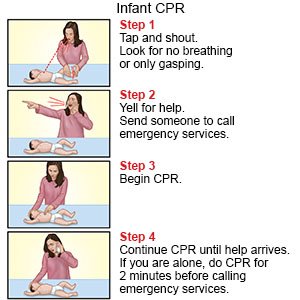 |
What should I do if I find an infant who is not breathing normally?
- Make sure the area is safe to enter, and approach the infant. Move the infant if the area is dangerous, such as in a fire. You may have to move the infant to a firm surface if he or she is on a soft surface, such as a sofa or mattress. The infant needs to be on a firm surface for chest compressions to be effective.
- Kneel beside the infant. Look to see if his or her head, neck, or back may be hurt. Carefully turn the infant onto his or her back while you support the head and neck. Keep the infant's body straight as you turn him or her. Try to get the infant to open his or her eyes. Tap the bottom of the infant's foot. Speak loudly or shout while you tap the foot.
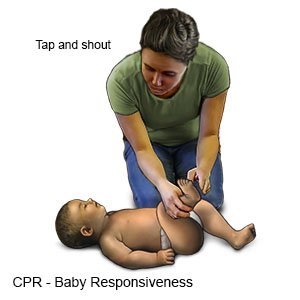
- Begin CPR if the infant is not breathing or is only gasping. Do 30 compressions immediately. Then open the infant's airway. Hold the airway open and give 2 rescue breaths. A cycle is 30 chest compressions and 2 rescue breaths.
- Call or go for help after 2 minutes of CPR.
- Continue CPR cycles until the infant responds, help arrives, or an automated external defibrillator (AED) becomes available. An AED is a device that gives a person's heart a shock if it is needed. AEDs are often kept in public areas and are usually mounted to a wall.
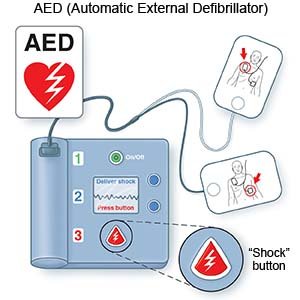
How do I give chest compressions?
Chest compressions press the heart between the spine and sternum (breastbone). This forces blood out of the heart and to the infant's brain and body.
- Put the pads of 2 fingers on the infant's sternum just below the nipple line. The sternum is where the infant's ribs meet in the middle of his or her chest.
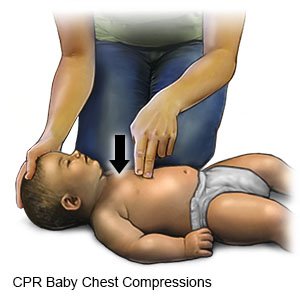
- Press straight down on the infant's sternum 1½ inches (4 centimeters). This should be at least ⅓ the depth of the infant's chest.
- Do not push your hands forward when you press down. Go only up and down. The compressions should be constant and equal. This means that it should take the same amount of time to press down as it does to go back up. Allow the chest to relax completely between compressions. This allows blood to come back into the heart before you compress again. Leave your hands on the infant's chest in the correct hand position between compressions.
- Do 30 chest compressions at a rate of at least 100 to 120 every minute. Push hard and push fast. Hard, fast compressions are more likely to keep the infant's brain and heart alive. Count the compressions out loud to help you do them at a steady, even speed.
How do I open an infant's airway?
- Put 1 hand on the infant's forehead and press firmly backward to tilt his or her head back. Do not place your hand on the back of his or her neck to tilt his or her head.
- Lift the infant's chin with your other hand. Hold his or her mouth open. Do not press deeply into the soft tissue under his or her chin, because this can close his or her airway.

- Look into the infant's mouth for something that may be blocking the airway. Examples are food and small toys. If you see something that looks easy to get, carefully scoop it out with your finger. Do not put your fingers in the back of the infant's throat unless you see something to remove.
How do I give rescue breaths to an infant?
- Take a deep breath and put your lips around the infant's nose and mouth, making an airtight seal. If your mouth is too small to cover both the infant's mouth and nose, pinch his or her nose closed. Cover his or her mouth with yours.
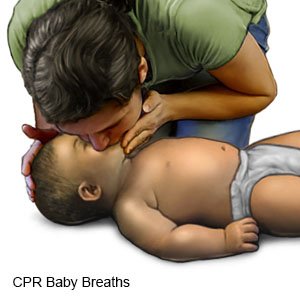
- Give 2 breaths (1 breath every 2 to 3 seconds) into the infant's mouth. The infant's chest will rise each time you give a rescue breath if his or her airway is open. Do not give large breaths. Do not breathe hard or fast. Take a normal breath for yourself after each breath that you give.
- Change the infant's head position to reopen his or her airway, if needed. If you cannot get air in, the airway may be blocked by an object. Look again to see if you find an object you can remove.
What can I do to help prevent respiratory and cardiac arrest in infants?
- Do not leave small objects within the reach of infants. Infants tend to put small objects into their mouths. Examples include batteries, coins, marbles, buttons, balloons, and small toys or toy parts. Do not allow an infant to hold anything small enough to fit through a toilet paper roll. This includes foods such as hot dogs, grapes, nuts, popcorn, and hard candy.
- Do not leave plastic bags within reach of an infant. An infant may put a plastic bag over his or her head.
- Keep drapery and extension cords out of an infant's reach. Do not put any type of cord or string around an infant's neck. Some examples include cords or strings with pacifiers or jewelry attached to them.
- Do not leave an infant alone in or near water. This includes a pool, bathtub, or pail of water.
- Keep an infant secured in a car safety seat while you are driving. Never leave an infant in a car alone.
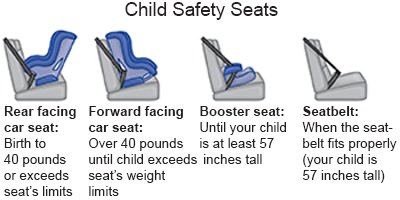
- Lay an infant on his or her back to sleep. An infant may be at more risk for sudden infant death syndrome (SIDS) if he or she sleeps on his or her stomach.
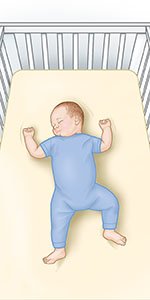
- Do not leave an infant alone on a high surface, such as a changing table.
- Keep cleaning supplies and other harmful products out of an infant's reach and locked up tightly.
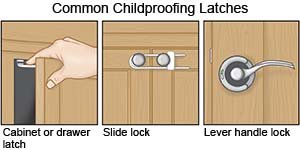
- Do not smoke near an infant.
Where can I find more information about CPR?
- American Heart Association
7272 Greenville Avenue
Dallas , TX 75231-4596
Phone: 1- 800 - 242-8721
Web Address: http://www.heart.org
Care Agreement
You have the right to help plan your baby's care. Learn about your baby's health condition and how it may be treated. Discuss treatment options with your baby's healthcare providers to decide what care you want for your baby. The above information is an educational aid only. It is not intended as medical advice for individual conditions or treatments. Talk to your doctor, nurse or pharmacist before following any medical regimen to see if it is safe and effective for you.© Copyright Merative 2025 Information is for End User's use only and may not be sold, redistributed or otherwise used for commercial purposes.
Learn more about Lay Person CPR On Infants
Care guides
Further information
Always consult your healthcare provider to ensure the information displayed on this page applies to your personal circumstances.
